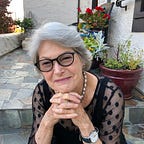Creativity in Post-Career Older Life
Last night my husband and I watched the Toni Morrison bio-documentary Toni Morrison: The Pieces I am. My husband does not read novels. He really doesn’t read books. I didn’t think he really knew who Toni Morrison was. He reads the news and listens to many podcasts and watches many YouTube videos.
So I said to him, I’m going to start the DVD while you take a shower because I don’t think you’ll be all that interested. Boy, was I wrong. It turns out that he was vaguely aware of Morrison, the writer. His connection, however, was to Morrison the human being. My husband grew up poor, with Jewish immigrant parents, in Queens, New York. He could identify with growing up poor in Lorraine, Ohio as Morrison did. He was fascinated by every aspect of her life — her education, her brief marriage, her children, her editing career at Random House, and her editor’s encouragement of her to write.
I, on the other hand, sat bolt upright on the couch when visual art showed her book covers, depictions of parts of the stories in her novels, and other African American artists’ portrayal of struggle, abuse, hard work and joy (of singing and dancing, of love and beauty). I’ve been taking drawing, painting, and collage classes online since the sheltering in place began in mid-March in California.
While I have poo-pooed the possibility that I have any artistic talent, and am experimenting with various media because it makes me happy, I saw, for the first time, that I’m also learning something about art. This is not the point of the documentary. But I saw that it was the point of actively creating art, which Morrison began to do with the writing and publication of The Bluest Eye, at age 39.
What I saw in the visual art work meant to compliment Morrison’s life story was that the visual art enhanced, deepened and provided immediacy to Morrison’s narrative art. I saw the point of art in a way I had never seen it before.
This, I think, is the point of pursuing something YOU call your art or your creativity in older life. Whatever it is — birdwatching, collecting old newsprint, watching (as my husband does) Old Jewish people telling jokes on YouTube, taking an improv acting class, or acting in community theater — it expands your freedom to experience joy.
I saw those beautiful Morrison book covers and I wanted to get better at drawing, not because I want to make another career out of illustration, but because I understood that what I was learning enabled me to SEE art in a newer and more informed and pleasurable way.
Find your art.
